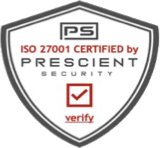Every organization establishes procedures, workflows, and internal controls to support business growth. Many operating entities invest in various technologies to assist with growth and streamline workflows.
But what happens when those established processes no longer support your business goals? It’s time to reevaluate things, and that’s why having an established internal control checklist greatly benefits your organization.
What is an internal control checklist?
An internal control checklist functions as a guide to assist with internal audits and checklists. Using the internal control checklist, managers strategically determine if established controls are still worthwhile. Should any weaknesses be detected, the audit will help teams make the business case to key stakeholders that it’s time to modernize outdated processes.
What is the purpose of an internal control checklist?
Internal controls are often complex systems with many interconnected processes weaved throughout the organization. If an entity operates at a global level with numerous subsidiaries reporting upward to the parent company, internal controls are even more complex.
Improved regulatory compliance
Every business must operate within the boundaries of the law. Organizations hold themselves to account using strict corporate compliance protocols to mandate legally bound operations. Using internal control checklists, businesses can create their corporate compliance programs and ensure each of the programs is effectively enforced.
Effective testing of internal controls
Regular internal audits help ensure internal controls continue to support business growth. Using internal control checklists, your team can proactively strengthen existing internal controls and adapt outdated processes that diminish growth potential.
Added protection against external audits
Internal audits, managed using internal control checklists, give stakeholders proper insight into employees, operations, and current uses of technology. The results from internal audits prepare executives should the business be subjected to external or compliance audits, both of which carry substantial financial, and potentially criminal consequences.
What items are included in an internal control checklist?
Most internal control checklists are organized into five main categories. The following are examples of how to measure the effectiveness of internal controls to protect the interests of the business entity.
1. Is there an effective control environment?
A control environment is a set of standards, processes, and principles to help govern the operations of the business. Elements of a control environment include a corporate code of conduct; governance, risk management, and compliance (GRC) protocols; as well as organizational charts to document the corporate hierarchy.
2. Are there established processes to mitigate risk?
Risk management is an important aspect of any internal control procedure. Having proper risk management policies ensures things like financial reporting to government regulators proceed without issue.
3. Does the company have control processes?
Control workflows ensure corporate transparency is maintained at every level of the organization. Examples of control processes include financial reporting, asset management, and data security protocols.
4. Have appropriate communication channels been implemented?
To establish proper controls and corporate transparency, there must be a framework in place to dictate proper communication channels throughout the organizational hierarchy. Ensure there is a method to facilitate these communications to ensure the proper information reaches the appropriate stakeholders at all times.
5. What technological resources help monitor internal controls?
The final step of an internal control checklist is accountability, and accountability is only achieved through effective monitoring of all corporate data. Having the right technology in place to assist with the monitoring and management of these corporate records enforces effective internal controls. Once enforced, internal controls protect the business from incurring costs brought about by external audits.
Use entity management software to enforce internal controls
The results of any effective internal audit should highlight gaps in current internal controls. Often, these gaps are a result of ineffective or outdated technology that places a lag on effective internal control workflows and the overarching goal of business growth.
Entity management software is a modern, intuitive, and effective resource to help enforce internal controls. Entity management platforms have built-in compliance frameworks to help businesses establish diligent compliance frameworks. The platform also has modules to build structured organizational charts, cap tables, and shareholder ledgers to document all financial data throughout the organization.
Most importantly, entity management software functions as a single source of truth for all reporting entity data. Any piece of information that can impact an internal control audit is hosted within the platform. If there are any questions or discrepancies about the results from an internal control checklist, your platform will have the answers to clarify those gaps. This will help finalize the audit while preserving the security and integrity of the corporate entity.
Join the MinuteBox revolution today to help modernize your internal control processes and preserve the growth and integrity of your organization.


